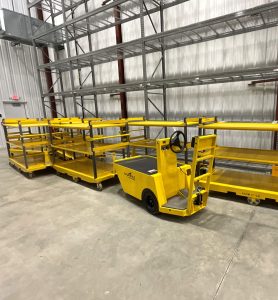Aluminum Roller Skatewheels
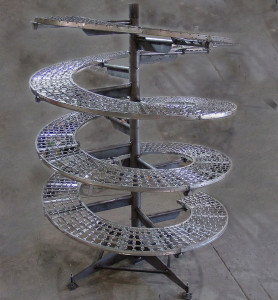 The aluminum frames, rollers, and skatewheels handle lighter weight cartons. They are preferred for portable conveyor travel paths and are used in noncorrosive environments. If you need a portable carton conveyor horizontal transportation concept, the aluminum conveyor frame is the preferred conveyor frame material because of its lighter weight.
The aluminum frames, rollers, and skatewheels handle lighter weight cartons. They are preferred for portable conveyor travel paths and are used in noncorrosive environments. If you need a portable carton conveyor horizontal transportation concept, the aluminum conveyor frame is the preferred conveyor frame material because of its lighter weight.
Belt Conveyors
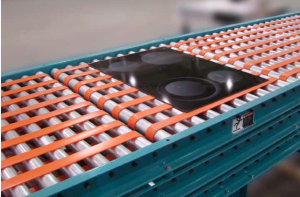 Belt Conveyors provide a versatile means of handling products of various sizes and shapes. General applications include:
Belt Conveyors provide a versatile means of handling products of various sizes and shapes. General applications include:
- Assembly lines
- Sorting
- Inspection
- Transportation
- Process systems
Belt Conveyors can be designed specifically for troughing or v-guided applications. For steep inclining or declining conveyors, a cleated belt can be added to help contain the product in the correct orientation.
Omni manufactures specially designed belt conveyors for specific industries such as:
- Wood panel processing & finishing
- Industrial laundry complexes
- Automotive assembly lines
- Distribution warehouses
- Box, bag, and tote handling
Slider Bed Conveyor
A class of belt conveyor that drives a continuous woven flat bed over a flat (usually) metal surface. Very economical in construction, this conveyor is well suited to medium length transport applications without accumulation requirements.
Belt on Roller Conveyor
In the same class as slider bed, this belt conveyor runs on a bed of passive rollers that reduce friction and power requirements. Slightly more costly than slider beds, it is usually used to accommodate heavier loads or greater distances with a given horsepower class of motor.
Conveyor Belt Curves
A special shaped belt and tapered drive rollers allow a continuous flat surface around (usually) 90 degree curves. Typically found in applications where loads of size variations would make roller curves impractical.
Spiral Belt Curve
A very specialized class of belt curve that forms a continuous helix shape for close quarters, inclines or declines. Saves a lot of floor space for elevation changes, but is relatively expensive.
Flexible Conveyors
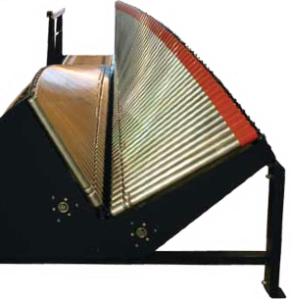 Flexible conveyors are a handy way to have a convenient conveyor line without having your workers walking around carrying boxes all day. This product can extend to almost 200% it’s original length and is able to go around corners with ease.
Flexible conveyors are a handy way to have a convenient conveyor line without having your workers walking around carrying boxes all day. This product can extend to almost 200% it’s original length and is able to go around corners with ease.
Many clients find this a good solution to loading and unloading trucks because it can be easily pushed out of the way when all loading operations are finished. Designed to expand, contract, flex, and move, these innovative conveyors can be used as stand-alone units or in combination with other conveyors in manufacturing, assembly, distribution and processing facilities.
Pallet Conveyors
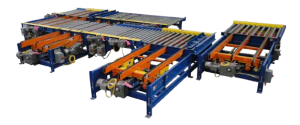 Pallet handling forms a vital part of all kinds of production and distribution processes. It extends right through the business process, from receiving of goods and materials up to shipping of finished products or sorted deliveries. That means fast, smooth and efficient handling of pallets is essential for the performance and reliability of those processes with pallet conveyors.
Pallet handling forms a vital part of all kinds of production and distribution processes. It extends right through the business process, from receiving of goods and materials up to shipping of finished products or sorted deliveries. That means fast, smooth and efficient handling of pallets is essential for the performance and reliability of those processes with pallet conveyors.
Plastic Roller / Skatewheels
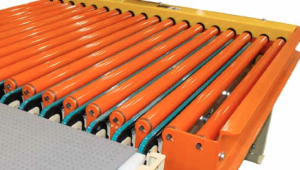 Heavy loads, accumulation, drainage or airflow, and the need to transport around a curve are all reasons to use plastic skate or roller conveyors.
Heavy loads, accumulation, drainage or airflow, and the need to transport around a curve are all reasons to use plastic skate or roller conveyors.
If your cartons sit on your conveying surface for a long period of time in a humid environment, plastic roller skatewheels tends to minimize the indentations to the cartons exterior bottom. These skatewheels are also considered for slippery, wet, wax-coated, or plastic cartons or containers. These skatewheels can improve carton travel and tracking through a curve.
Roller Conveyors
 Roller conveyors feature a robust design for reliability in intense operations. Roller conveyor modules can be varied in pitch and width to suit various pallet sizes and load weights. The height of the conveyor can also be altered to suit the application (e.g., to ensure an ergonomic working height at order picking stations).
Roller conveyors feature a robust design for reliability in intense operations. Roller conveyor modules can be varied in pitch and width to suit various pallet sizes and load weights. The height of the conveyor can also be altered to suit the application (e.g., to ensure an ergonomic working height at order picking stations).
When to use Roller Conveyors:
- When the carton exterior bottom surface is soft, narrow, irregular, and medium length because the rollers provide a wide carton-riding surface;
- With a soft carton bottom exterior surface, a skate wheel conveyor can cause indentations in the carton surface; and
- If your cartons are heavy, use roller conveyors for a wide surface support and capacity.
Skatewheel Conveyors
 When your cartons are lightweight, the skatewheel conveyor surface is the preferred riding surface because the skatewheels rotate easier.
When your cartons are lightweight, the skatewheel conveyor surface is the preferred riding surface because the skatewheels rotate easier.
When to use Skatewheel Conveyor:
- If the shape of the carton bottom exterior is hard, regular, long, and flat, the skatewheel conveyor is preferred because of its low cost and because it permits the carton to travel across the conveyor surface.
Steel Roller Conveyors
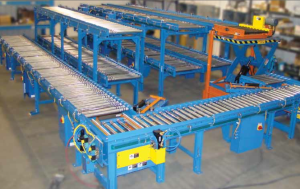 The steel conveyor frames and steel skatewheels or rollers are preferred for heavy cartons and for fixed (permanent) conveyor travel paths because of its durability and costs. It is also ideal for food equipment and other wash-down operations.
The steel conveyor frames and steel skatewheels or rollers are preferred for heavy cartons and for fixed (permanent) conveyor travel paths because of its durability and costs. It is also ideal for food equipment and other wash-down operations.
What are the benefits of stainless steel?
- Corrosion Resistance: Lower alloyed grades of stainless steel resist corrosion in atmospheric and pure water environments, while high-alloyed grades can resist corrosion in most acids, alkaline solutions, and chlorine bearing environments – properties utilized in process plants.
- Hygiene: The easy cleaning ability of stainless steel makes it the first choice for strict hygiene conditions, such as hospitals, kitchens, abattoirs, and other food processing plants.
- Aesthetic Appearance: The bright, easily maintained surface of stainless steel provides a modern and attractive appearance.
- Strength-to-Weight Advantage: The work hardening property of austenitic grades of stainless steel that results in a significant strengthening of the material from cold working alone, allows reduced material thickness over conventional grades, therefore savings on costs.
- Ease of Fabrication: Modern steelmaking techniques mean that stainless steel can be cut, welded, formed, machined, and fabricated as readily as traditional steels.
- Long-term Value: When the total life cycle costs are considered, stainless steel is often the least expensive material option.

